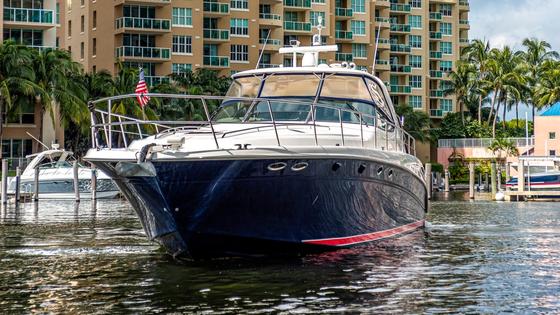A hull free of marine growth keeps a boat working at its peak hydrodynamic performance level. A clean hull is safe, fast, and efficient; a bottom that is fouled (the appropriate maritime industry term) cuts speed and maneuverability and lowers fuel economy. Also, a clean hull makes a boat far more marketable to potential renters and looks good when underway.
If your boat stays in the water for at least part of the year, a good coat of anti-fouling paint will enable peak performance. Many boaters find bottom painting messy, tedious, and time-consuming, but it is one of the key preventative maintenance jobs that keeps a boat shipshape.
It is important to remember that modern bottom paints are designed to perform a specific purpose, use highly-developed science to do their jobs, come in a dizzying array of names, removal and application techniques, and have complex paint and hull compatibility issues. Stringent air, soil, and water pollution protection measures are involved in hull cleaning and painting. These and other factors, including regional environmental regulations, can be overwhelming for a boater tackling a hull paint job for the first time. The best approach may be to find a boatyard that provides hull-painting services to do the job initially and to participate as much as possible in the project to learn how to do it correctly.
Bottom Paint Prevents Marine Growth on Boat Hulls
Protecting hulls from marine growth has its roots in the days of sail, when wooden sailing vessels were severely affected by barnacles, algae, other creatures, and seaweed that attached to their hulls. Thin sheets of copper were affixed to the hull to prevent the marine growth, which was generally effective. As steel became the predominant material for ship hulls, paints that contained copper and later, tin, were developed to protect the hulls.
Beginning in the 1950s, anti-fouling paints were formulated with other special chemicals like tributyltin (TBT), organotin compounds, and other biocides to impede marine organism growth. In the 1960s and 1970s, bottom paints containing TBT became the industry standard for anti-fouling applications on commercial and recreational vessels. The substance was banned a few years ago around the globe because of its serious toxic effects on humans, marine life, and the environment.
Tips for a Boat's Bottom Paint
The following tips about bottom painting provide a very basic primer about bottom painting, information about paint types, and recommendations about how to approach a painting project.
- A regular regimen of hull washing and inspection after every use is the short-cut way to avoid costly and tedious bottom painting efforts. Even with attentive maintenance, the hull will eventually need repainting. Keep an eye out for paint that is cracked, excessively faded, or peeling.
- Sloughing or ablative bottom coatings contain biocides that kill marine organisms, like barnacles and algae and are formulated to “ablate,” or gradually wear off, exposing a fresh layer of biocide. Ablative anti-fouling paint will not lose its effectiveness even if the boat is stored out of the water.
- A range of other biocide compounds and materials are available in modern bottom paints. Their application depends on the type of hull and whether the boat is used in salt, brackish or fresh water, how frequently the boat is underway, where it is stored, and to a degree, the region of the country where the boat is used.
- To prepare for a bottom painting project, determine the type of paint on the hull, which may take some detective work, especially if the boat was bought used. If the hull paint is unknown but a new coat is needed, applying a tie-coat primer prepares the unknown surface and allows a new coat of any anti-fouling paint to be applied.
- Particularly if the hull is of fiberglass construction, prepare the hull for painting by blasting with environmentally-friendly materials like walnut shells, baking soda, glass beads,or corncobs.
- Closely follow manufacturer instructions and safety precautions when applying new paint and removing paint already on the boat.
- Use plastic sheets under the boat to collect paint chips, sanding residue, and drips, Dispose the material responsibly.
- Optimal painting conditions are at temperatures between 50-80 degrees and when relative humidity is below 65%.
- Wear protective clothing, especially for the eyes and hands, and a mask to protect lungs.
- Paint with a zinc or a copper biocide is best for aluminum hulls or sterndrives.
- Modified epoxy paint is best for boats used infrequently because it has good antifouling properties when the boat is inactive.
- For boats in the water year-round, a high copper-content modified epoxy paint that prevents growth by leaching biocides upon contact with water is best. This type of paint releases the biocide at a decreasing rate, leaving the hard coating of the original thickness.
The Future of Bottom Paint
The combination of advanced research in paint technology and marine biology continues to produce innovative bottom paints that are increasingly less toxic to the marine environment and to humans. One type provides good anti-fouling protection by producing hydrogen peroxide when exposed to the sun or artificial light. Another development for replacing cooper and tin in anti-fouling paint is slime. Micromesh covering a boat’s hull contains a material which turns into a viscous slime on contact with water and coats the micromesh. The slime constantly ablates, carrying away microorganisms and barnacle larvae as it wears away.
Today’s bottom paints are designed to perform a specific purpose, use highly-developed science to do their jobs, and have complex paint and hull compatibility issues. Strict environmental measures around the country affect how boat hulls are cleaned, stripped, and repainted. Understanding all facets of hull painting and the variety of available paints can save money, time, and effort, and provide protection for the hull that meets user needs.
Learn about the various types of hulls and what they are best used for in this article.










